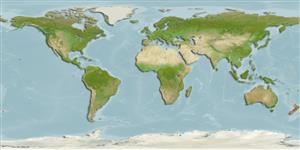Environment: milieu / climate zone / depth range / distribution range
Ecología
marino; agua dulce; salobre demersal; catadromo (Ref. 51243). Subtropical; 34°S - 47°S
Southwest Pacific: endemic to New Zealand.
Length at first maturity / Tamaño / Peso / Age
Maturity: Lm ?, range 80 - ? cm
Max length : 185 cm TL macho / no sexado; (Ref. 44724); 156.0 cm TL (female); common length : 60.0 cm TL macho / no sexado; (Ref. 9258); common length :100 cm TL (female); peso máximo publicado: 25.0 kg (Ref. 11115)
Commonly found in lakes and rivers (Ref. 9258). Inhabits stony rivers (Ref. 9072). Migrates to the sea to breed. Oviparous (Ref. 205). Marketed fresh, smoked and frozen; eaten fried and broiled (Ref. 9988). Reports of reaching up to 2 meters and 50 kilograms are rare and more common historically; in recent times, only a few exceed 120 cm TL (Ref. 82796).
Life cycle and mating behavior
Madurez | Reproducción | Puesta | Huevos | Fecundidad | Larva
Armitage, R.O., D.A. Payne, G.J. Lockley, H.M. Currie, R.L. Colban, B.G. Lamb and L.J. Paul (eds.), 1994. Guide book to New Zealand commercial fish species. Revised edition. New Zealand Fishing Industry Board, Wellington, New Zealand, 216 p. (Ref. 9258)
IUCN Red List Status (Ref. 130435)
Threat to humans
Harmless
Human uses
Pesquerías: comercial; Acuicultura: experimental
Más información
ReferenciasAcuiculturaPerfil de acuiculturaRazasGenéticaElectrophoresesheritabilidadEnfermedadesProcesamientoNutrientsMass conversion
Herramientas
Special reports
Download XML
Fuentes de Internet
Estimates based on models
Preferred temperature (Ref.
123201): 10.6 - 18.3, mean 15.1 °C (based on 138 cells).
Phylogenetic diversity index (Ref.
82804): PD
50 = 0.5000 [Uniqueness, from 0.5 = low to 2.0 = high].
Bayesian length-weight: a=0.00093 (0.00076 - 0.00115), b=3.20 (3.15 - 3.25), in cm total length, based on LWR estimates for this species (Ref.
93245).
Nivel trófico (Ref.
69278): 4.5 ±0.5 se; based on diet studies.
Resiliencia (Ref.
120179): Muy bajo, población duplicada en un tiempo mínimo superior a 14 años (Tmax=60; tm=10-48 years based on age-length relationship.).
Fishing Vulnerability (Ref.
59153): Very high vulnerability (90 of 100).
